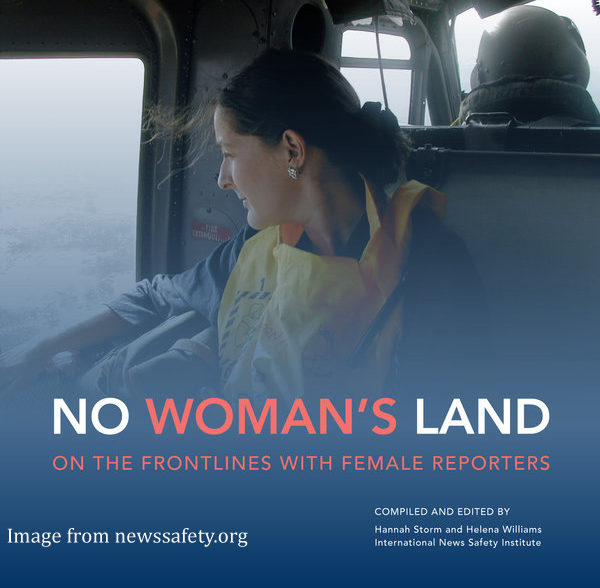THE PRESS AND THE GENDER: SAFETY OF FEMALE JOURNALISTS.

Nagsen Torne is a graduate in Bioanalytical Sciences from Ramnarain Ruia College and is currently pursuing a Masters degree in Public Policy Analysis. He is a kickboxer and also a bibliophile who loves learning. He believes that a pen, a few words and an idea can bring about the greatest of social revolutions.
THE PRESS AND THE GENDER: SAFETY OF FEMALE JOURNALISTS.
Journalism is one of the dangerous jobs in current times. A noble profession as it is, journalism requires that journalists put themselves in contexts of war, conflict and natural disasters. In order to report on corruption, human rights abuses and political turmoil, journalists often incur the wrath of the most powerful in society.
Like most professions, journalism historically has been considered a male profession and hence women often encounter sexism from their colleagues as well as from outsiders on this account.
The women in the ‘news’ profession regularly need to tackle the field challenges like their male colleagues however daunting those might be. However, the organizational space within which they need to operate poses additional challenges which are often gender specific leading to inequitable working conditions. In the profession a woman journalist faces many constraints in her day-to-day life. For instance, lack of separate toilets on the field, safety, issues related to maternity leaves and certain other requirements.
Across the globe, women reporters now, cover the most vital and challenging stories of our generation and put their personal safety on the line to detail corruption, socio-economic divisions, politics and war. They do so in a variety of environments, each of which produces a separate set of risks. The correspondent covering political and sometimes violent demonstrations in Kashmir must be vigilant toward a host of concerns that are quite separate than those encountered by the woman covering organized crime in Bihar, or the one living through and reporting on instability abroad in the Middle East.
For some unfortunate women journalists, this danger extends to the workplace, as the prevalence of sexual harassment in newsrooms across the world is well-documented. Ammu Joseph’s 2005 research with Indian women journalists chronicled widespread harassment that ranged from gossip and character assassination to touching and demands for sexual favours. While some newsrooms adopt anti-harassment policies, the personal and professional implications of workplace harassment mean some victims never report the abuse.
While threats, abuse and violence are part of many journalists’ experiences, a number of these types of incidents take on a gender or sexual component when directed at women. The perpetrators of violence, threats and abusive behaviour toward women journalists range from government authorities and criminal gangs to their co-workers, bosses and sources. In some cases, a female journalist is just not taken seriously or made fun of, as in this case of America’s Republican Presidential candidate, Donald Trump. Female reporters developed an ingenious protest video to use Donald Trump’s words against him. Besides in some newsrooms, female journalists are asked to cover “soft” news and are mostly hired to add “glamour” to the news channel. While researching about the “adding glamour” part for the previous line, I was shocked when I stumbled upon a news channel itself listing news reporters, rated according to their “hotness”.
The increase in the use of social media has given rise to a new form of abuse of female journalists. Journalist abuse can be recorded on social websites like Facebook and Twitter. Although, male reporters are also harassed for their differing views, the abuse takes an ugly turn in the case of female reporters. A recent spur in online harassment of female journalists in India by right-wingers took the nation by a storm. A term “presstitute” is commonly used in the current Indian social media scenario which is a portmanteau of “press” and “prostitute”. The Indian Child Development Minister Maneka Gandhi, owing to these infamous reports, had announced that women being harassed on Twitter should post complaints using the hashtag #IamTrolledHelp or mail grievances directly to her. These complaints, said Gandhi, were forwarded by her to the National Commission for Women (NCW). The organisation NCW now also monitors instances of trolling and online abuse of women.
Impact of Intimidation, Threats and Abuse
The impact is that the female reporter becomes concerned for her personal security and in some instances becomes depressed and experiences psychological trauma. Some female reporters use pseudonyms or pen names after receiving threats. The Nobel laureate Malala Yousafzai used to publish her blog on BBC Urdu with a pen name,” Gul Makai”. Others decide to stop reporting from specific regions, while a few are forced to permanently relocate.
Impact of Physical Violence
Physical violence affects female reporters psychologically, leaving them with feelings of anger, fear and guilt. Some are physically harmed by the violence. Reporter Logan was beaten by a mob in Egypt while covering a political turmoil.
Impact of Sexual Harassment
Sexual harassment also has psychological consequences. An American journalist, victim of sexual harassment said,“I was overwhelmed by shame, humiliation and anxiety. I would sit in my office in a cold sweat.” Other victims also cite emotional effects. Some say that they blame themselves for the treatment. A Spanish journalist victim said “I kind of tried to forget about it and moved on but ended up in psychological therapy years later, as I suffered from really bad self-esteem, depression, extreme fear of men and being around them.” Victims then make an effort to change their behaviour around others, including not making eye contact, not attending work social functions (when harassment occurred in the workplace) and not forming friendships with anyone related to work. They also modify the way they dress for work, or make an effort to present themselves as personally conservative.
A case where a female reporter travels with Band-Aids to cover peepholes of her hotel door to avoid stalkers shows the length to which the impact can be felt. To protest against such cases and also to raise awareness about them, a female freelance reporter for VICE tweeted a video of her sexual assault.
A few measures to curb these dreadful impacts are:
- The adoption of a gender and equal opportunity policy, independent gender assessments and affirmative employment strategies.
- The development of family-friendly work conditions, a ‘zero-tolerance’ policy for sexual harassment at the workplace and the implementation of a gender-sensitive code of ethics.
- The need for media organizations to inform and educate the public in promoting gender equity, reporting and illustrating the changing roles of women and recognising the negative impact of discriminatory laws, polices and social-cultural attitudes.
- An increase in women’s union representation, amended constitutions and statutes to ensure structures are ‘women-friendly’, the implementation of union gender equity and model sexual harassment policies and the creation of a checklist for union action on gender equity.
Besides other preventive measures like providing physical/self-defence technique training to reporters moving to sensitive areas, insuring check-in protocols and securing transport to/from an assignment can be put in place. Other things like flexible work hours so that assignments do not extend into nights, first aid lessons and trauma counselling sessions can also help. Female journalists, as a matter of fact, even male journalists should research the location, language, culture and customs in advance and make informed decisions about how she/he will conduct her/his work. When appropriate, she/he should establish local contacts vetted by her/his news organisation, colleagues, or other reliable sources in advance of her/his departure. Journalists should be clear about their travel arrangements and schedules, even when field reporting locally. They should leave contact details with a trusted person and have the appropriate documents with them, including relevant permits, press passes and insurance. They should carry out a risk assessment, have the appropriate training and equipment when possible and ensure they have a contingency plan to get out of trouble if the situation deteriorates.
As the safety of female journalists becomes certain, more women will look for a career in this noble profession and “the girls at the front” will let us see the world from a woman’s eye. It will be a refreshing perspective, different from a patriarchal media that has developed over the decades. This will not just be good for women—it will be good for the world!


